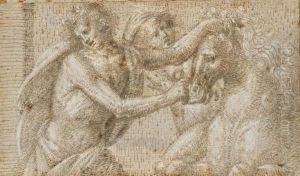Pseudo Gherardi Paintings
Pseudo Gherardi, also known as Maestro degli Occhi Spalancati (Master of the Wide-open Eyes), is an enigmatic figure in the history of art, whose precise identity and life details remain largely obscure. The name Pseudo Gherardi is an art-historical moniker assigned to an anonymous Italian painter or group of painters active during the 16th century, primarily because the style of the works is reminiscent of, yet distinct from, that of the better-known artist Eusebio di San Giorgio, known as Il Gherardi.
The works attributed to Pseudo Gherardi are characterized by their vivid expression and the portrayal of figures with notably wide-open eyes, which is where the alternative name 'Master of the Wide-open Eyes' comes from. This stylistic feature has allowed art historians to group a collection of paintings together under this pseudonym. These works often depict religious themes and narratives, which was typical for the period. The paintings exhibit a combination of influences from the Umbrian and Florentine schools of the Renaissance, suggesting that the artist(s) may have been exposed to or trained under various regional styles and influences.
Due to the scarcity of records, the biography of the artist(s) behind the name Pseudo Gherardi cannot be fully assembled. The lack of signed or documented works further complicates the task of reconstructing a comprehensive picture of their life and career. However, the distinct style of the paintings attributed to Pseudo Gherardi has allowed them to be recognized and studied within the context of Renaissance art. The artworks continue to be subjects of research, with art historians attempting to piece together information that could shed light on this mysterious figure or collective.
The anonymity of Pseudo Gherardi is not unique in the history of art. Many artists from the past, especially prior to the modern era, remain unknown, with their works coming to light only through the diligent efforts of art historians and scholars. The legacy of Pseudo Gherardi, therefore, lies not in the personal biography of the artist, but in the body of work that has been attributed to them, which contributes to our understanding of the artistic landscape of Renaissance Italy.
